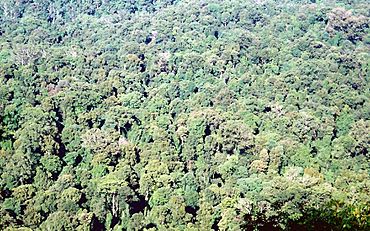Toonumbar National Park facts for kids
Quick facts for kids Toonumbar National ParkNew South Wales |
|
|---|---|
|
IUCN Category II (National Park)
|
|

Tall sub tropical rainforest at Toonumbar National Park
|
|
| Nearest town or city | Woodenbong |
| Established | 22 December 1995 |
| Area | 149.1 km2 (57.6 sq mi) |
| Managing authorities | NSW National Parks & Wildlife Service |
| Website | Toonumbar National Park |
| See also | Protected areas of New South Wales |
The Toonumbar National Park is a special protected area in New South Wales, Australia. It's a national park found in the Northern Rivers region. This park covers about 14,910 hectares (that's like 149 square kilometers!). It's located around 620 kilometers north of Sydney, close to the town of Woodenbong.
Toonumbar National Park is part of something very important called the Gondwana Rainforests of Australia. This group of rainforests is so special that it's listed as a World Heritage Site. It was added to this list in 1986 and later to the Australian National Heritage List in 2007.
Contents
What Makes Toonumbar National Park Special?
This park is home to amazing subtropical rainforests. These forests protect many plants and animals that are rare or in danger.
Animals of the Park
You can find several unique animals here. Some of them include:
- the sooty owl
- the red-legged pademelon (a small marsupial, like a mini-kangaroo)
- the yellow-bellied glider (a possum that can glide through the air)
Other animals living in the park are the marbled frogmouth (a type of bird), koalas, and the famous Albert lyrebird. You'll also find many rainforest reptiles and frogs. The rainforest is a safe place for fruit-eating pigeons and bats that eat insects.
Plants and Landscapes
The rainforests on Dome Mountain and the Murray Scrub are part of the World Heritage listed Gondwana Rainforests. These areas have both subtropical and temperate rainforests. The park also has drier and cooler spots. This mix creates an incredible variety of plants. You can see eucalypt woodlands, tall gum forests, and even forests of bangalow palms.
The landscape itself is very rugged and beautiful. Mountains like Mount Lindesay, Dome Mountain, and Edinburgh Castle stand tall. These impressive mountains have inspired many local Aboriginal stories and legends.
How the Mountains Were Formed
About 23 million years ago, a volcano called Focal Peak Volcano was active. This volcano, located in Mt Barney National Park, helped create the mountains you see today. Mount Lindesay, Dome Mountain, and Edinburgh Castle are actually old, eroded parts of that ancient volcano.
The park gets a lot of rain, about 1035.8 mm each year on average. The most rain ever recorded in one day was 449.4 mm! This high rainfall, along with rich soil, helps the lush rainforests grow so well.
Aboriginal Connection to the Land
Toonumbar National Park is very important to the Githabul people, the traditional owners of this land. They have a deep connection to the park.
Sacred Sites and Stories
Inside the park, there are special places called jurabihls. These are important spiritual sites for the Githabul people. They are very rare and hold great cultural meaning.
Dome Mountain is a sacred site for the Githabul rain ceremony. Edinburgh Castle is also a special site, known as the Goanna site. It belongs to the descendants of Clara Williams, who live at the Muli Muli Aboriginal Reservation, about 10 kilometers west of Woodenbong.
Gallery
-
Syzygium francisii (left) and Argyrodendron trifoliolatum (right), 40 metres tall - Toonumbar National Park
-
Carpet python (Morelia spilota mcdowelli) digesting a meal at Toonumbar National Park
See also
 In Spanish: Parque nacional Toonumbar para niños
In Spanish: Parque nacional Toonumbar para niños





